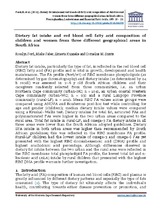| dc.contributor.author | Ford, Rosalyn | |
| dc.contributor.author | Faber, Mieke | |
| dc.contributor.author | Kunneke, Ernesta | |
| dc.contributor.author | Smuts, Cornelius M. | |
| dc.date.accessioned | 2018-07-11T07:36:12Z | |
| dc.date.available | 2018-07-11T07:36:12Z | |
| dc.date.issued | 2016 | |
| dc.identifier.citation | Ford, R. et al. (2016). Dietary fat intake and red blood cell fatty acid composition of children and women from three different geographical areas in South Africa. Prostaglandins, Leukotrienes and Essential Fatty Acids, 109: 13 – 21. | en_US |
| dc.identifier.issn | 0952-3278 | |
| dc.identifier.uri | http://dx.doi.org/10.1016/j.plefa.2016.04.003 | |
| dc.identifier.uri | http://hdl.handle.net/10566/3872 | |
| dc.description.abstract | Dietary fat intake, particularly the type of fat, is reflected in the red blood cell (RBC) fatty acid (FA) profile and is vital in growth, development and health maintenance. The FA profile (%wt/wt) of RBC membrane phospholipids (as determined by gas chromatography) and dietary intake (as determined by 24 h recall) was assessed in 2–6 y old South African children and their caregivers randomly selected from three communities, i.e. an urban Northern Cape community (urban-NC; n = 104), an urban coastal Western Cape community (urban-WC; n = 93) and a rural Limpopo Province community (rural-LP; n = 102). Mean RBC FA values across groups were compared using ANOVA and Bonferroni post-hoc test while controlling for age and gender (children); median dietary intake values were compared using a Kruskal–Wallis test. Dietary intakes for total fat, saturated FAs and polyunsaturated FAs were higher in the two urban areas compared to the rural area. Total fat intake in rural-LP, and omega-3 FA dietary intake in all three areas were lower than the South African adopted guidelines. Dietary SFA intake in both urban areas was higher than recommended by South African guidelines; this was reflected in the RBC membrane FA profile. Rural-LP children had the lowest intake of omega-3 and omega-6 FAs yet presented with the highest RBC docosahexaenoic acid (DHA) profile and highest arachidonic acid percentage. Although differences observed in dietary fat intake between the two urban and the rural area were reflected in the RBC membrane total phospholipid FA profile, the lowest total fat and α-linolenic acid (ALA) intake by rural children that presented with the highest RBC DHA profile warrants further investigation. | en_US |
| dc.language.iso | en | en_US |
| dc.publisher | Elsevier | en_US |
| dc.rights | This is the author-version of the article that was published online at: http://dx.doi.org/10.1016/j.plefa.2016.04.003 | |
| dc.subject | Dietary intake | en_US |
| dc.subject | Fatty acids | en_US |
| dc.subject | Red blood cell | en_US |
| dc.subject | Children | en_US |
| dc.subject | Women | en_US |
| dc.subject | South Africa | en_US |
| dc.title | Dietary fat intake and red blood cell fatty acid composition of children and women from three different geographical areas in South Africa | en_US |
| dc.type | Article | en_US |
| dc.privacy.showsubmitter | FALSE | |
| dc.status.ispeerreviewed | TRUE | |
| dc.description.accreditation | ISI | |

